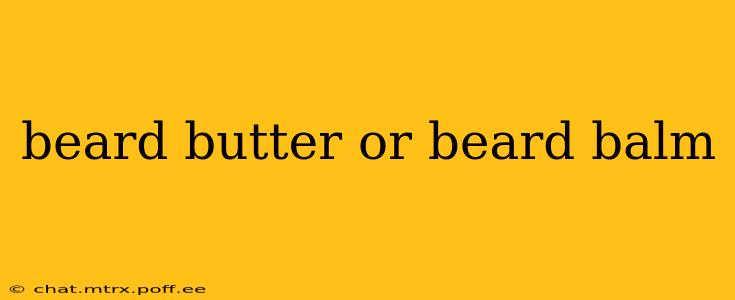Choosing between beard butter and beard balm can feel overwhelming. Both products aim to soften, condition, and style your beard, but they differ significantly in their ingredients and effects. This comprehensive guide will help you understand the key differences and determine which product best suits your beard's needs and your personal preferences.
What is Beard Butter?
Beard butter is a lighter, more moisturizing product compared to beard balm. It typically consists of a blend of natural butters (like shea butter, mango butter, or cocoa butter), oils (such as argan oil, jojoba oil, or coconut oil), and sometimes essential oils for scent. The lighter consistency makes it easily absorbed into the skin and beard hair, leaving it feeling soft and hydrated without a heavy, greasy residue. It's excellent for moisturizing dry skin underneath the beard and adding a subtle shine.
What is Beard Balm?
Beard balm is thicker and usually contains a higher concentration of beeswax or other waxes, providing stronger hold and styling capabilities. While it also includes moisturizing oils and butters, the waxes provide structure and help to shape and control unruly beard hairs. Beard balm is ideal for those seeking more hold and definition, especially for thicker or longer beards. It's also effective at taming frizz and flyaways.
Beard Butter vs. Beard Balm: Key Differences
| Feature | Beard Butter | Beard Balm |
|---|---|---|
| Consistency | Lighter, creamier | Thicker, waxier |
| Hold | Minimal to light | Moderate to strong |
| Moisturization | High, easily absorbed | Moderate, can feel slightly heavier |
| Shine | Subtle, natural-looking | Can be more noticeable, depending on ingredients |
| Scent | Often more subtle, depends on essential oils | Can be more pronounced, depending on ingredients |
| Best for | Softening, moisturizing, short-to-medium beards | Styling, hold, taming frizz, longer beards |
What are the ingredients in beard butter and balm?
Both beard butter and balm utilize natural ingredients to benefit your beard and the skin underneath. Common ingredients include:
- Butters: Shea butter, mango butter, cocoa butter (provide deep conditioning and moisturization).
- Oils: Argan oil, jojoba oil, coconut oil, castor oil (moisturize, add shine, and promote healthy hair growth).
- Waxes: Beeswax, carnauba wax (provide hold and structure in balms).
- Essential Oils: Lavender, tea tree, cedarwood (provide scent and potential skin benefits).
It's crucial to check the ingredient list of specific products to ensure they align with your needs and preferences. Look for natural and organic ingredients whenever possible, and avoid products with harsh chemicals or synthetic fragrances.
Which is better for sensitive skin?
For sensitive skin, beard butter is generally preferred due to its lighter consistency and less potential for irritation. The added waxes in beard balm can sometimes clog pores or cause breakouts in individuals with sensitive skin. However, always test a small amount of any new product on a less visible area of skin before applying it to your entire beard and face.
How do I use beard butter and beard balm?
Both products are applied similarly:
- Cleanse: Wash your beard and face with a gentle cleanser.
- Dry (partially): Pat your beard dry, leaving it slightly damp.
- Apply: Take a small amount of product (pea-sized for butter, slightly larger for balm) and rub it between your hands to warm it.
- Massage: Gently massage the product into your beard and skin, working from the roots to the tips.
- Style: Use a comb or brush to style your beard as desired.
Ultimately, the choice between beard butter and beard balm depends on your individual beard type, length, desired level of hold, and skin sensitivity. Experimenting with both products might be the best way to determine which one works best for you.
